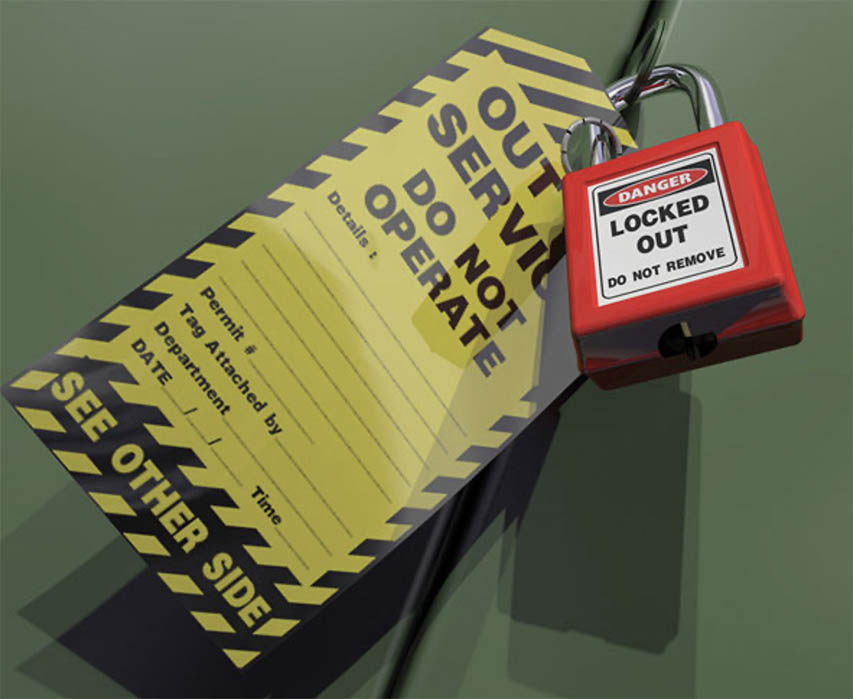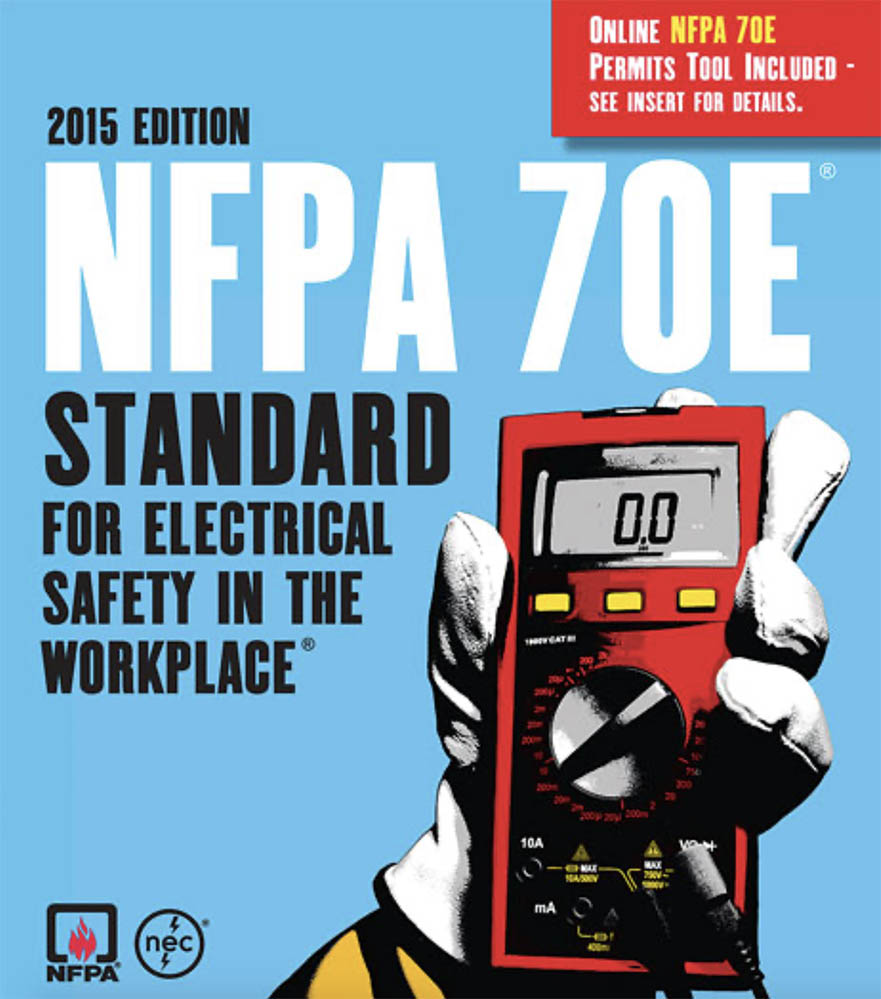Being Electrically Safe
Establishing an Electrically Safe Work Condition
How Do You Know if Your Work Condition is Electrically Safe?
Article 100 in NFPA 70E, Standard for Electrical Safety in the Workplace, defines the phrase “electrically safe work condition” as “A state in which an electrical conductor or circuit part has been disconnected from energized parts, locked/ tagged in accordance with established standards, tested to ensure the absence of voltage, and grounded if determined necessary.” Is this what you have when you work? How do you know?

starting work. Test for the presence of voltage before you touch!
Did you notice that definition includes verification? You don’t just lock/tag something — you must test it to ensure there’s no voltage.
Verification is so important that Art. 120 begins with verification requirements instead of putting them near the end (where they would be if following the work flow). There’s more to verification than just taking a voltage measurement. It’s actually a six-step process [120.1]:
- Determine all possible sources of electrical supply to the equipment you’ll be working on. Ensure the drawings and diagrams you consult are current; check the revision numbers and dates. Also check equipment identification tags.
- First disconnect the load (following the recommended procedure), and then open the disconnecting device (e.g., disconnect switch or OCPD). For example, you shut off the motor by pushing the stop button (which presumably causes the motor controller to interrupt power to the motor), and then you open the local disconnect. Don’t do this in reverse and open the disconnect while under load.
- Where possible, visually verify all blades of the disconnecting device are fully open or drawout breakers are fully drawn out.
- Follow your lockout/tagout policy to affix locks and tags.
- Verify the circuit is dead, using the appropriate test equipment and applying the three-step method described in 120.1. And test each phase conductor phase-to-phase and phase-to-ground; this is how you protect yourself from (among other hazards) backfed power.
- If induced voltage or stored electrical energy may be possible on the circuit you just de-energized, then ground the phase conductors before touching them.
This process does not address other forms of energization or energy storage, such as hydraulic or mechanical. But don’t ignore them; ensure a qualified person addresses them.
For example, you need to crawl under the raised ram of a hydraulic press to work on a motor. What is the procedure for removing the potential energy threat? Does a mechanic install blocks that prevent the ram from coming down and also disconnect the hydraulic lines?
And how is the de-energization verified? Don’t pretend to be an expert in these non-electrical systems. Find someone who will apply the same vigor in verifying de-energization that you use while isolating your equipment from electrical energy sources. Be sure to apply your locks and tags to those other sources as well.
Lockout Tagout Basics

Some industries (e.g., electric utilities) were using lockout/tagout programs before OSHA began requiring them. OSHA has required them for a long time now, yet we continue to see fatalities due to program failures. Usually it’s because the employer failed to provide adequate training even in the basics. These basics apply to any lockout/tagout program:
- The lockout/tagout procedure must be appropriate for the experience and training of the employees and conditions as they exist in the workplace [120.2]. Meeting this criterion can be a challenge. Simply putting requirements on paper and expecting people to understand and correctly implement them violates not just 102.2, but also the integrity of your lockout/tagout program.
- All circuit conductors are considered energized until the sources of energy are removed.
- No circuit conductors are considered to be in an electrically safe condition until proven so via appropriate testing.
- Lockout/tagout applies to all equipment, regardless of whether it is permanent, temporary, or portable.
Lockout/tagout Principles
We find nine principles enumerated in 120.2(B)(1) through (9):
- Employee involvement. It’s a mistaken notion that just one person on a crew affixes locks. Any person who could be exposed (even indirectly) to a source of electrical energy “shall be involved in the lockout/tagout process.”
- Training. Those involved employees from the first principle must be trained to understand the procedure to control energy and their responsibilities in executing that procedure.
- Retraining. People must be retrained every three years (or less), or when the procedure is revised.
- Training documentation. The employer must document the training has been
given, but the training counts only when the employee demonstrates proficiency in the work practices involved. - Plan. The employer must develop a plan based on the equipment and system, using current-revision drawings that accurately depict the installation.
- Control of energy. “All sources of electrical energy shall be controlled in such a way as to minimize employee exposure to electrical hazards.”
- Identification. OSHA requires that each employee have his or her own identifiable locks dedicated to this purpose [1910.147(c)(5)]. NFPA 70E states this requirement in a succinct way that could be misinterpreted; employees must understand the OSHA requirement.
- Voltage. Remove it and verify it’s gone.
- Coordination. The lockout/tagout procedure must be coordinated with all other procedures associated with lockout/tagout of other energy sources. Not all energy sources are electrical. Hydraulic systems, for example, can store energy.
Know Your Responsibilities
The employer is responsible for:
- Establishing the organization’s lockout/tagout procedures [120.2(C)(1)].
- Training employees in using those procedures.
- Providing the equipment (locks, tags, hasps, etc.) for executing those procedures.
- Auditing the execution of the procedures to ensure employee understanding and compliance.
- Auditing the procedures for improvement opportunity and completeness. This must be performed at least annually by a qualified person [120.2(C)(3)].
Simple or Complex?
Two types of electrical energy control exist: simple and complex [120.2(C)(2)]:
- A simple procedure involves locking out only one set of conductors (or circuit part). You don’t need to write out a plan for each application. Each worker is responsible for his or her own lockout/tagout [120.2(D)(1)]. Example: Two electricians are replacing a motor; each one affixes his lock to the disconnecting device.
-
A complex procedure is anything other than a simple one. It requires a written plan of execution [Informative Annex G 9.1 and 120.2(D)(2)(b)]. It vests primary responsibility in an authorized employee for a set of employees working under the protection of a group lockout or tagout device. Example: Both the electricians and the mechanics are working on the equipment; each worker hangs his tag on a common hasp and the production supervisor provides oversight for that equipment.
Complex procedures accommodate things like multiple energy sources, crews, shifts, and disconnecting means. For example, suppose the job you’re working will continue on the next shift. Do you remove your locks and tags, or leave those for the next crew? The details of a complex lockout/tagout are in 120.2(D), but the short answer is you can’t share locks or leave equipment in an unsafe condition. A common solution is a supervisor also affixes a master lock at each lockout. Then any crew can remove all personal locks. Absent that, you’ll probably need to walk that relieving crew through the lockout/tagout so they can place their locks and tags as you remove yours.
Lockout devices
Each lockout device must meet the seven requirements enumerated in 102.2(E) (3)(a) through (g):
(a) It must include a lock.
(b) It must include a means of identifying who locked it.
(c) It can be just a lock if it is readily identifiable as a lockout device.
(d) It shall be attached in a way that prevents operation of the disconnecting means.
(e) Where a tag is used with the device, the tag must include a statement prohibiting unauthorized operation of the disconnecting means or unauthorized removal of the device.
(f) It must be suitable for the environment and the duration of the lockout.
(g) The key or combination to the lock must remain in the possession of the person installing the lock or the person in charge.
Note that (e) has specific implications under federal law (OSHA). Basically, if it’s your lock, then nobody else can remove it except under special circumstances and following a special procedure with special permission. For example, you left on a week’s vacation and did not remove your lock. The operations supervisor and maintenance supervisor each provide a removal authorization signature once the written prerequisites have been satisfied per the company’s lockout/ tagout procedures.
Tagout devices must meet the five requirements enumerated in 102.2(E)(4)(a) through (e). These are aimed at ensuring the tag is going to stay on the lock, stay legible, and be readily identifiable as a tagout means. One way to meet this last requirement is to purchase tags specifically designed for that purpose. If all of your lockout tags have red stripes and the words “LOCKED OUT” on them, their purpose is obvious.
Robots need not apply
There’s much in Art. 120 that we didn’t cover, such as the extensive requirements for the lockout/tagout procedures. Article 120 isn’t intended to replace awareness, thinking, or personal responsibility. Always examine the system on which you’re working.
Before performing lockout/tagout, look for potential problems (e.g., the disconnect doesn’t have a locking means). After performing lockout/tagout, walk the system down again; this is really your only “second chance,” so make sure it’s right.

